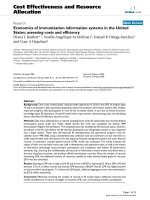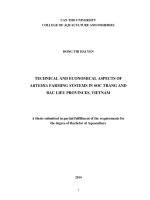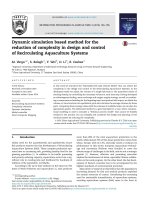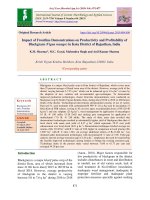An economics and profitability of predominant farming systems in restored tank areas undertaken under Mission Kakatiya
Bạn đang xem bản rút gọn của tài liệu. Xem và tải ngay bản đầy đủ của tài liệu tại đây (328.7 KB, 9 trang )
Int.J.Curr.Microbiol.App.Sci (2020) 9(5): 1290-1298
International Journal of Current Microbiology and Applied Sciences
ISSN: 2319-7706 Volume 9 Number 5 (2020)
Journal homepage:
Original Research Article
/>
An Economics and Profitability of Predominant Farming Systems in
Restored Tank Areas Undertaken under Mission Kakatiya
Salla Sowjanya* and R. Vijaya Kumari
Department of Agricultural Economics,
Jayashankar Telangana State Agricultural University, India
*Corresponding author
ABSTRACT
Keywords
Mission Kakatiya,
farming systems,
rehabilitation of
tank
Article Info
Accepted:
10 April 2020
Available Online:
10 May 2020
Tanks have been the main source of irrigation in many parts of India for centuries. In this
connection, the Government has prioritized to take the restoration of minor irrigation tanks to
restore them to store their original capacity and to effectively utilize of water allocated for
Minor irrigation sector.The main aim of the Mission Kakatiya is improving the rural economy
by encouraging the diversified enterprises. The present studies is on economics and profitability
of predominant farming systems in areas with tank and without tank farms have been analyzed
component wise and the pattern of total costs, gross returns, and returns per rupee spent on
farming systems were worked out using simple budgeting technique. The number of farming
systems followed by farmers in tank area before and after renovation was found to be 9, while
the same with respect to area without tank was 18. In areas with tank, the profitability high for
Paddy-Paddy+Dairy followed by Paddy-Paddy+Dairy+Poultry and Paddy-Paddy+Dairy+Goat
farming systems with returns per rupee spent was 1.72, 1.71 and 1.70 respectively. Whereas, in
areas without tank the returns per rupee was 2.10, 1.79 and 1.77 for Paddy+ Lime, PaddyPaddy +Cotton and Paddy-Paddy +Cotton +Dairy respectively. It is confirmed that the paddy
cultivation is carried out in both the seasons for majority of the farmers in areas with tank, as
the water availability was increased after rehabilitation of tank under Mission Kakatiya
programme. It could be concluded that the farming systems with diversified enterprises are
highly profitable and with minimum risk.
Introduction
Water is one of the most valuable resources in
the world and is vital to all known forms of
life. Its availability determines where and how
animals and plants exist on Earth. Water
covers about 3/4 of the earth's surface, but
only about 2% is fresh water, and a larger
portion of it is polar ice. 86% of Asia's fresh
water is used for agriculture, 8% for industry
and 6% for domestic purposes. Our country
uses 83% of fresh water for agriculture.
(www.cpreec.org).
The per capita water availability in the
country is reducing progressively due to
increase in population. The average annual
per capita availability of water in the country,
1290
Int.J.Curr.Microbiol.App.Sci (2020) 9(5): 1290-1298
taking into consideration the population of the
country as per the 2001 census, was 1816
cubic meters which reduced to 1545 cubic
meters as per the 2011 census. (Government
of India, 2015).
Rainfed agriculture constitutes for 55 per cent
of net sown area in the country. The annual
average rainfall of the country varies from
400 to more than 2000mm varying in both
space and time. India uses only 10-20 percent
of its annual rainfall. When it rains, only a
fraction of the water percolates and reaches
the ground water aquifers, while the major
part of the rainfall drains out as run-off and
goes unused into the ocean.
Further, lack of adequate storage facilities
necessitate water being let into the sea to
prevent breaching and flooding. The
increasing numbers and depth of borewells
and wells and their unrestricted use threaten
India's ground water resources.
Tanks have been the main source of irrigation
in many parts of India for centuries. Irrigation
tanks are one of the oldest and most important
common property water resources in the
resource poor regions especially in South
India. In this connection, understanding the
importance of reclamation of tanks for growth
in the state, the Government of Telangana
State has taken up the programme of restoring
the minor irrigation sources under the title
“Mission Kakatiya” (Mana Ooru – Mana
Cheruvu) in 2014. The mission aims at
retrieving the lost glory of minor irrigation in
the state with community participation for
ensuring sustainable water security.
As per survey 46,531 number of M.I, Small
tanks, Percolation tanks, Private Kuntas and
Small tanks (built by Forest Department)
were distinguished for restoration. The
irrigation department has planned to restore
all the 46,531 minor irrigation sources in the
state in next five years in five phases, taking
up 20% of the tanks each phase i.e., 9306 per
year
().
The main objective of this mission is to
enhance the development of agriculture based
income for small and marginal farmers by
accelerating the development of minor
irrigation
infrastructure,
strengthening
community based irrigation management and
adopting a comprehensive programme for
restoration of tanks.
An Integrated farming system (IFS) is one
which focuses on judicious combinations of
any one or more of agriculture enterprises and
effective recycling of wastes and crop
residues for better management of available
resources with small and marginal farmers to
generate more income and employment for
family labourers during off seasons. These
enterprises not only supplement the income of
the farmers but also help in increasing the
family labour employment throughout the
year.
In general, the small and marginal farmers
practice subsistence farming where they need
to produce a continuous, reliable and balanced
supply of foods, as well as cash for basic
needs and recurrent farm expenditure.
Therefore, there is a need to develop suitable
integrated farming systems for such farmers
since
monocropping /
single crop
production enterprise is subjected to high
degree of risk and uncertainity because of
seasonal, irregular and uncertain income and
employment to the farmers.
The main aim of the Mission Kakatiya is
improving the rural economy by encouraging
the diversified enterprises, the present study
on “An economics and profitability of
predominant farming systems in restored tank
areas undertaken under Mission Kakatiya”
1291
Int.J.Curr.Microbiol.App.Sci (2020) 9(5): 1290-1298
has been undertaken to identify the
predominant integrated farming systems, to
work out the economics and profitability of
integrated farming systems.
Materials and Methods
Warangal and Nalgonda districts, where more
number of tanks were selected for restoration
under Mission Kakatiya in the year 2014-15
was purposively selected for the present
study.
One tank in each district selected for the
study. Using random sampling technique, a
sample of 180 beneficiary households were
selected from each restored tank in each
district and 180 non-beneficiary households
who are not covered under Mission Kakatiya
were selected. Thus, a total of 720 households
(360 from each district) were form the sample
size for present study.
The primary data related to cost and returns,
resource use etc collected from the selected
sample farmers to fulfill the objective of the
study using a pre tested schedule.
The present studies is on economics and
profitability of predominant farming systems
in areas with tank and without tank farms
have been analysed component wise and the
pattern of total costs, gross returns, and
returns per rupee spent on farming systems
were worked out using simple budgeting
technique.
Results and Discussion
The number of farming systems followed by
farmers in tank area before and after
restoration of tank was found to be 9, while
the same with respect to area without tank
was 18. The various components included in a
farming system by the sample farmers in the
study area were paddy, cotton, red gram,
green gram, ground nut, acid lime, maize,
dairy, goat and poultry rearing activities.
The details of the different farming systems
followed by sample farmers before and after
restoration of tank are presented in Table 1
(Fig.1 and Fig. 2). Among 360 sample
respondents maximum per cent of farmers
were
found
practicing
PaddyPaddy+Dairy(32.22 %) fallowed by PaddyPaddy + Dairy + Poultry ( 23.61 %), PaddyPaddy (20.28 %), Paddy + Dairy (9.72 %),
Paddy-Paddy+Poultry
(6.67%),
PaddyPaddy+Dairy+Goat
(3.06%),
PaddyPaddy+Goat+Poultry
(2.22
%),
Paddy+Sheep+Poultry (1.67%) and PaddyPaddy+Sheep (0.56 %) before restoration of
tank.
When the same observed after restoration of
tank (Table1 and Fig. 2), the highest
proportion of sample farmers practicing a
farming system consisting of PaddyPaddy+Dairy (36.39%), followed by PaddyPaddy + Dairy + Poultry (27.22 %), PaddyPaddy (13.06% ) Paddy-Paddy+Poultry (7.78
%)and
Paddy-Paddy+Dairy+Goat(5.00%),
other farming systems were in less
percentage.
Among 360 sample farmers in study area
without tank (Table 2 and Fig 3) , maximum
per cent of sample farmers were practicing
Paddy+Cotton (18.61%), followed by PaddyPaddy+Cotton (12.22%), paddy - paddy +
dairy system (10.56%), paddy- paddy + red
gram (10.00 %), paddy and dairy system
(8.89%) and Paddy+ Acid Lime (1.67%),
otherfarming systems were in less percentage.
An
economics
and
profitability of
predominant farming systems observed after
restoration of tank were presented in Table 3.
Out of total nine farming systems adopted by
farmers as with tank only five farming
systems were identified as predominant based
on the percentage of adoption.
1292
Int.J.Curr.Microbiol.App.Sci (2020) 9(5): 1290-1298
Table.1 Different farming systems adopted before and after restoration of
tank by sample farmers
Farming system
P- P
P-P+D
P-P+D+G
P-P+G+Po
P-P+D +Po
P-P+S
P-P+Po
P+D
P+S+Po
Total
Before restoration of tank
Number
Percent to
of
total
farmers
73
116
11
8
85
2
24
35
6
360
20.28
32.22
3.06
2.22
23.61
0.56
6.67
9.72
1.67
100
After restoration of tank
Number of Percent to
farmers
total
47
131
18
15
98
2
28
15
6
360
13.06
36.39
5.00
4.17
27.22
0.56
7.78
4.17
1.67
100.00
P-Paddy, D-Dairy, S-Sheep, Po-Poultry, G-Goat
Table.2 Different farming systems adopted by sample farmers in areas without tank
Farming system
P-P
P-P+D
P-P+D+Po
P-P+D+S
P+D+Po+G
P-P+RG
P-P+RG+D
P-P+RG+D+Po
P-P+C
P+C
P-P+C+D
P+L
P+L+D
P+GN+D
P-P+GG
P-P+GG+D
P+M+D
P+D
Total
Number of farmers
14
38
17
10
3
36
23
7
44
67
26
6
4
7
9
13
4
32
360
Percent to total
3.89
10.56
4.72
2.78
0.83
10.00
6.39
1.94
12.22
18.61
7.22
1.67
1.11
1.94
2.50
3.61
1.11
8.89
100.00
P-Paddy, D-Dairy, S-Sheep, Po-Poultry, G-Goat, RG- Red gram, GG- Green gram, GN- Ground nut, L- Acid
Lime, M-Maize, C- Cotton
1293
Int.J.Curr.Microbiol.App.Sci (2020) 9(5): 1290-1298
Table.3 Component wise per farm cost and returns of predominant farming systems adopted by
farmers with tank
Component
Area
(ha) /no.
Total cost
(Rs.)
Gross return
Rs.
Net return
(Rs.)
Return
per rupee
spent
FS I- (P-P+D)
Paddy (kharif)
0.52
28690
51369
22679
1.79
Paddy (rabi)
0.52
29992.2
47634.9
17642.7
1.59
Dairy
2.7
35100
62641
27541
1.78
93782.2
161645
67862.7
1.72
Total
FS II- (P-P+D+Po)
Paddy (kharif)
0.62
33110
57963
24853
1.75
Paddy (rabi)
0.62
34159.4
55964.6
21805.2
1.64
3
38340
65962
27622
1.72
5.3
1213.7
2356
1142.3
1.94
106823
182246
75422.5
1.71
Dairy
Poultry
Total
FS III- (P-P)
Paddy (kharif)
0.36
19563
31875
12312
1.63
Paddy (rabi)
0.36
22931.5
35589
12657.5
1.55
42494.5
67464
24969.5
1.59
Total
FS IV- (P-P+Po)
Paddy (kharif)
0.32
17900
30126
12226
1.68
Paddy (rabi)
0.32
19069.6
29022.4
9952.85
1.52
Poultry
7.5
2215
4175
1960
1.88
39184.6
63323.4
24138.9
1.62
Total
FS V- (P-P+D+G)
Paddy (kharif)
0.43
21658
34656.3
12998.3
1.60
Paddy (rabi)
0.43
23456
35487
12031
1.51
Dairy
1.6
14213
25654
11441
1.80
Goat
8.9
22525.8
43241
20715.2
1.92
81852.8
139038
57185.5
1.70
Total
1294
Int.J.Curr.Microbiol.App.Sci (2020) 9(5): 1290-1298
Table.4 Component wise per farm cost and returns of predominant farming systems adopted by
farmers without tank
Component
Area
(ha) /no.
Total cost
(Rs.)
Gross
return
(Rs.)
Net return
(Rs.)
Return
per rupee
spent
FS I- (P-P+D)
Paddy (kharif)
1.4
68300
110262
41962
1.61
Paddy (rabi)
1.4
70265
108568
38303
1.55
Dairy
2.1
26457
46845
20388
1.77
165022
265675
100653
1.61
Total
FS II- (P-P+RG)
Paddy (kharif)
0.75
41946
68936
26990
1.64
Paddy (rabi)
0.75
40136
65256
25120
1.63
Red gram
0.6
26471
45895
19424
1.73
108553
180087
71534
1.66
Total
FS III- (P-P+C)
Paddy (kharif)
0.36
18924
31950
13026
1.69
Paddy (rabi)
0.36
20654
32412
11758
1.57
Cotton
1.61
89129
166524
77395
1.87
128707
230886
102179
1.79
Total
FS IV- (P+C)
Paddy
0.24
13425
22145
8720
1.65
Cotton
1.2
71923
126861
54938
1.76
85348
149006
63658
1.75
Total
FS V- (P +D)
Paddy
0.37
18764
32421
13657
1.73
Dairy
2
24558
44523
19965
1.81
43322
76944
33622
1.78
Total
FS VI- (P+L)
Paddy
Acid lime
Total
0.29
15587.5
27531.9
11944.4
1.77
2
252642
536785
284143
2.12
268230
564317
296087
2.10
1295
Int.J.Curr.Microbiol.App.Sci (2020) 9(5): 1290-1298
Figure.1 Different farming systems adopted before restoration of tank by sample farmers
Figure.2 Different farming systems adopted after restoration of tank by sample farmers
Figure.3 Different farming systems adopted by sample farmers in areas without tank
1296
Int.J.Curr.Microbiol.App.Sci (2020) 9(5): 1290-1298
Total cost for FS - I, FS - II, FS - III, FS - IV
and FS - V were Rs. 93782.2, Rs. 106823, Rs.
42494.5, Rs. 39184.6 and Rs. 81852.8
respectively. Similarly, gross returns from FS
- I, FS - II, FS - III, FS - IV and FS - V were
Rs. 161645, Rs. 182246, Rs. 67464, Rs.
63323.4 and Rs. 139038. The return per rupee
spent for the total system for FS - I, FS - II,
FS - III, FS - IV and FS - V was 1.72, 1.71,
1.59, 1.62 and 1.70 respectively.
Devasenapathy et al., (1995) also reported
that the integrated farming with GroundnutBlackgram-Maize and Groundnut-GingellyRagi with integration of other enterprises such
as dairy, poultry and rabbit rearing resulted in
higher net income and benefit-cost ratio. An
economics and profitability of six major
farming systems in without tank areas were
presented in Table 4. Total cost for FS - I, FS
- II, FS - III, FS – IV, FS – V and FS – VI
were Rs.165022, Rs. 108553, Rs. 128707, Rs.
85348, 43322 and Rs. 268230 respectively.
Similarly, gross returns from FS - I, FS - II,
FS - III, FS - IV FS – V and FS – VI were Rs.
265675, Rs. 180087, Rs. 230886, Rs. 149006,
76944 and Rs. 564317 respectively. The
return per rupee spent for the total system for
FS - I, FS - II, FS - III, FS – IV, FS – V and
FS – VI was 1.61, 1.66, 1.79, 1.75, 1.78 and
2.10 respectively. The results are similar to
the results of Rangaswamy (1999).
The socio-economic characters of the sample
farmers were, majority number of respondents
belonged to middle age (36-55 years) in both
tank and non-tank areas. The educational
level of sample farmers in the case of tank
area was higher than the non-tank area.
Majority of the farmers selected under tanks
were marginal followed by small farmers. The
farmers in tank area had high socio-political
participation, as compared to sample farmers
in non-tank area. The average farm size of the
respondents with tank was 0.44 ha and
without tank was 1.36 ha.
It was noted from the Table 1 and 2, that
paddy was one of the major agriculture
components in all the farming systems in the
selected area. Majority farmers in the study
area with tank cultivated paddy in both kharif
and rabi seasons due to availability of the
water. The irrigation facilities are more for
tank beneficiary farmers compared to farmers
in area without tank. The area cultivated
under paddy increased after restoration of the
tank under Mission Kakatiya when compared
to before restoration of the tank. The main
aim of the Mission Kakatiya is improving the
rural economy by encouraging the diversified
enterprises. Areas without tank in Nalgonda
district, horticultural crop (Acid lime)
component was also appeared in good number
of farming systems.
It is confirmed from the Table 3 and 4, that
the paddy cultivation is carried out in both the
seasons by majority farmers in tank area, as
the water availability was increased after
restoration of tank under Mission Kakatiya
programme. From the presented results it
could be concluded that the farming systems
with diversified enterprises are highly
profitable with minimum risk.
Policy implications
The state agricultural department should take
initiatives
for
further
promotion
diversification of farming systems through
their wide spread extension activities.
Government
should
encourage
the
community-based tank management system to
increase the availability of water for
diversified crops and livestock.
Acknowledgment
I gracefully record my profound sense of
gratitude and regards to the chairman and
major advisor, DR. R. Vijaya Kumari,
Associate Professor in the Department of
1297
Int.J.Curr.Microbiol.App.Sci (2020) 9(5): 1290-1298
Agricultural Economics and minor advisors
Dr. T. Lavanya, AssociateProfessor in the
Department of Agricultural Economics, Dr.
Seema, Associate Dean, College of
Agriculture, Rajendranagar, PJTSAU and Dr.
D. Srinivasa Chary, Associate Professor,
Statistics and Mathematics, PJTSAU and Dr.
K. Suhasini (Univ. Head) Professor& Head,
Department of Agricultural Economics,
College of Agriculture, PJTSAU for the
unbounded affection, cheerful assistance and
encouragement during my course of study.I
humbly thank the authorities of Professor
Jayashankar Telangana State Agricultural
University and Government of Telangana for
the financial help in the formofstipend
duringmystudyperiod.
References
Basavaraj, H. 1999. Economic assessment of
integrated farming systems. In : Lecture
Notes of Summer Short Course on Farming
Systems for Sustainable Production.
University of Agricultural Sciences,
Dharwad., 24th May to 2nd June 1999.
270-274.
Devasenapathy, P., Mytswamy, V., Christopher
Louduraj, A and Rabindran, R. 1995.
Integrated farming systems for sustained
productivity. Madras. Agricultural Journal.
82: 306-307.
Ganesan, S., Chinnaswami, K. N., Chandraskaran,
B., Budhar, M. N. and Prince Jayaseelan,
M. J. 1991. Duck-cum-fish culture in
farming systems in Cauvery delta region of
Tamil Nadu: The Aduthurai experiment.
Indian Journal of Agricultural Economics.
46 (2): 180-185.
Kandasamy, O. S. 1998. An economic analysis of
IFS in Dharmapuri District of Tamil Nadu.
Farming Systems. 14 (12): 29-33.
Palanisami, K. 2006. Sustainable management of
tank irrigation systems in India.Water
Technology
Centre,
Tamil
Nadu
Agricultural University, India.
Rangaswamy, A. 1999. Integrated farming
systems for sustainable crop production.
Lecture notes of summer short course on
farming systems for sustainable production.
University of Agricultural Sciences,
Dharwad. 1-20.
Saikumar, B. C. 2005. Farming systems in the
tank commands in north eastern Karnataka
- an economic analysis of JalaSamvardhane
Yojana Sangha managed tanks. M.Sc
Thesis. University of Agricultural Sciences
GKVK, Banglore.
Sharma, L. R., Bhhati, J. P. and Ranveer, S. 1991.
Emerging farming systems in Himachal
Pradesh-Key issues in sustainability. Indian
Journal of Agricultural Economics.
46(3):422427.
Singh, S. N., Saxena, K. K., Singh, K. P., Harish
Kumar and Kadian, V. S., 1997,
Consistency in income and employment
generation in various farming generation in
various farming systems. Mannual of
Agricultural Research. 18(3): 340-363.
Swaminathan, M. S. 1996. Integrated intensive
farming systems. Indian Farming. 46(7):
5960.
Tanver Ahmed. 2006. An economic analysis of
paddy based farming systems in Southern
Karnataka – A case study of Mandya
district. M.Sc Thesis. University of
Agricultural Sciences, Dharwad.
www.cpreec.org
How to cite this article:
Salla Sowjanya and Vijaya Kumari. R. 2020. An Economics and Profitability of Predominant
Farming Systems in Restored Tank Areas Undertaken under Mission Kakatiya.
Int.J.Curr.Microbiol.App.Sci. 9(05): 1290-1298. doi: />
1298









